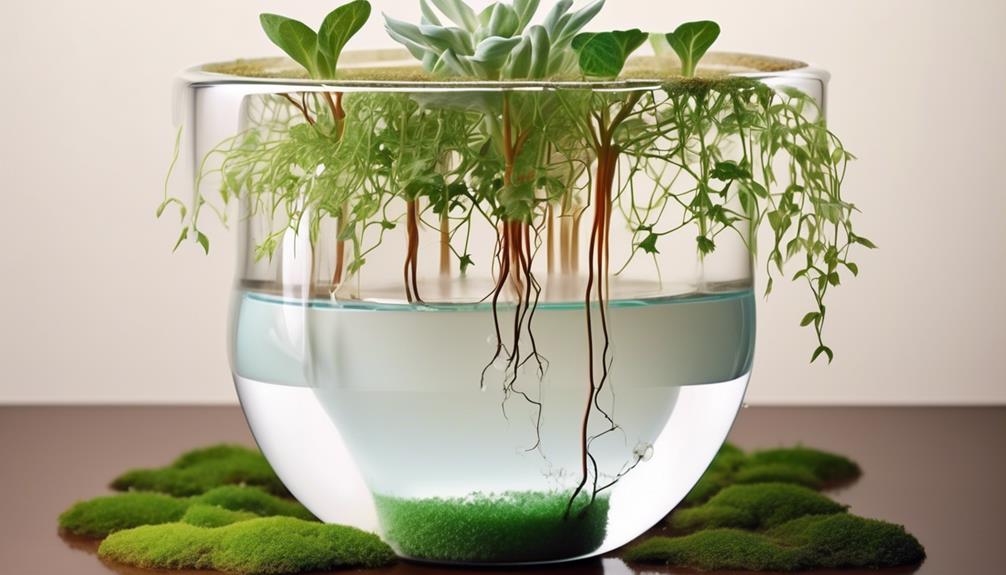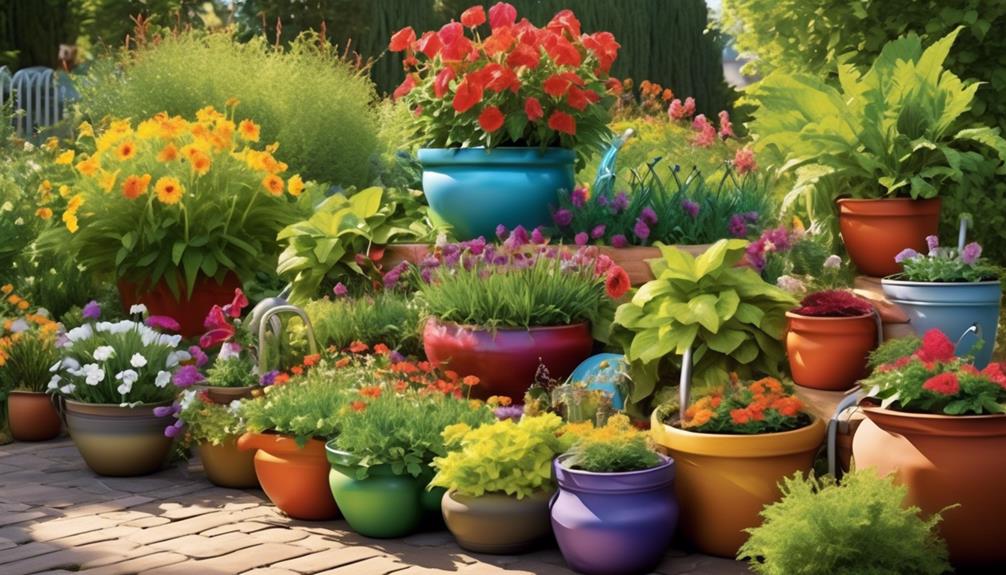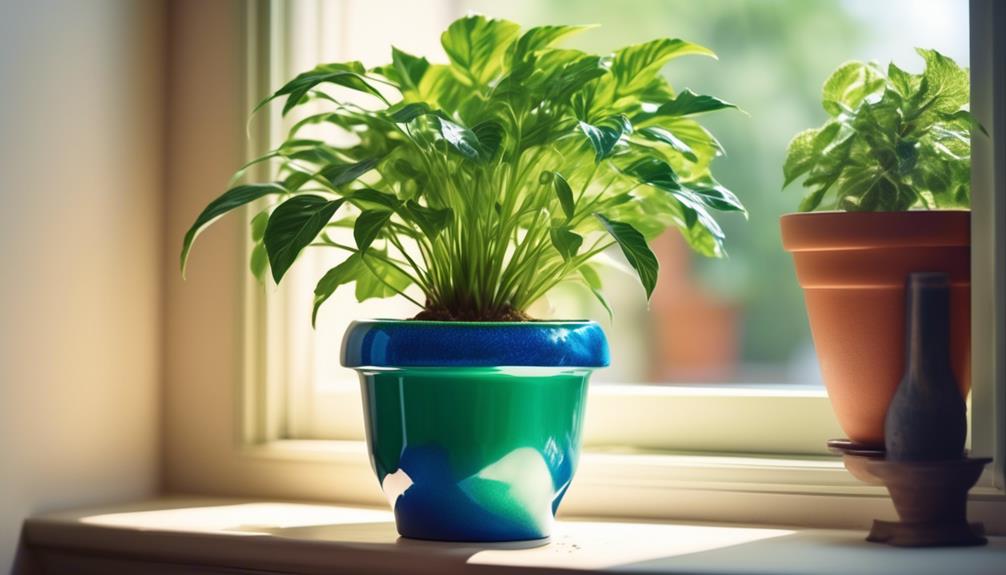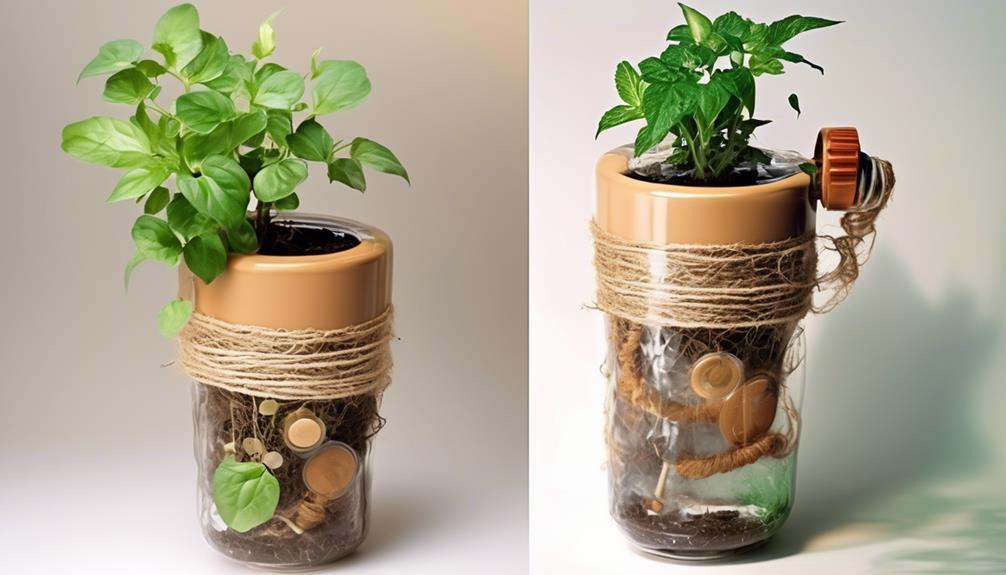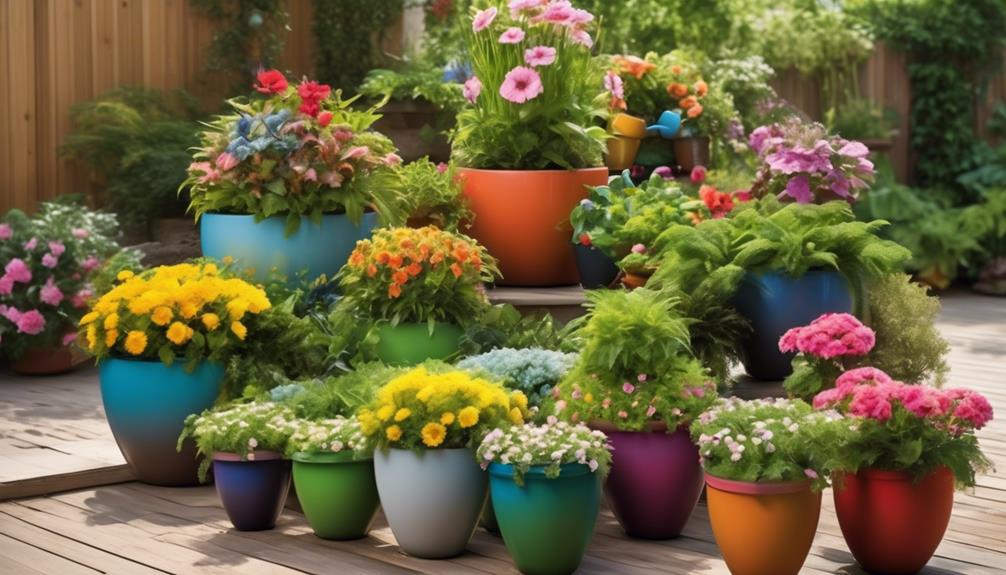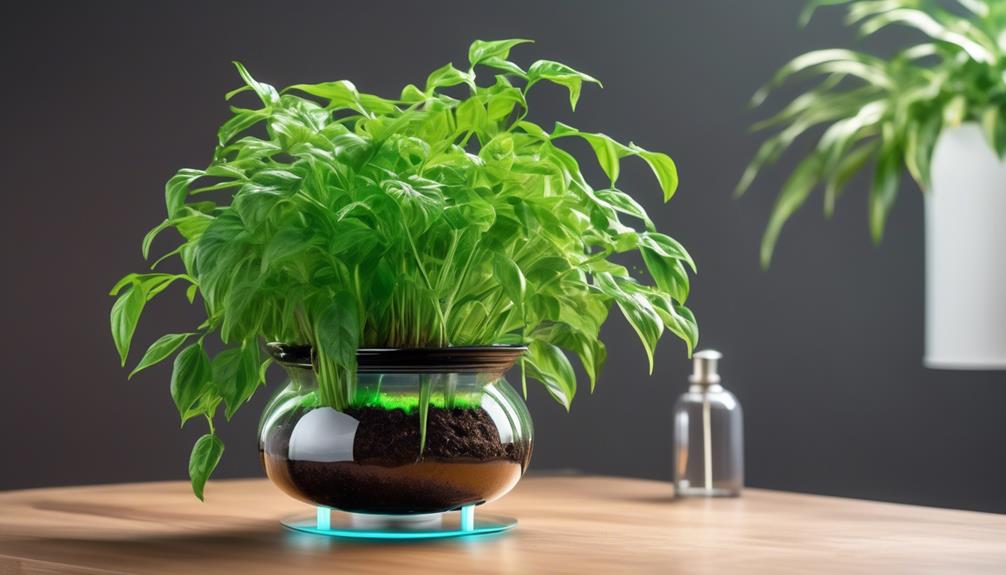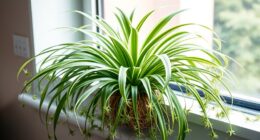Have you ever imagined a planter that relieves you from the repetitive task of constantly watering to ensure its growth? Self-watering planters provide a fascinating innovation that has revolutionized the way we nurture our plants, both indoors and outdoors.
But what exactly is a self-watering plant pot, and how does it work? Let's explore the ins and outs of these innovative gardening tools, from their basic functionality to the various designs available in the market.
Key Takeaways
- Self-watering pots utilize a reservoir system to supply water to plant roots.
- They offer watering efficiency and reduce water wastage.
- They minimize the risk of overwatering and promote healthier root development.
- Choosing suitable plants ensures optimal growth and health in self-watering pots.
The Basics of Self-Watering Pots
Self-watering pots, also known as sub-irrigation planters, utilize a reservoir system to supply water to the plant's roots as needed. These innovative containers consist of a water reservoir at the bottom and a growing medium on top, which is separated from the water by a wicking mechanism. The wick, often a fabric strip or rope, draws water from the reservoir into the soil, ensuring a constant supply of moisture to the plant. This mechanism mimics the natural capillary action that occurs in soil, providing an efficient and consistent source of hydration for the plant.
When it comes to plant care, self-watering pots offer several advantages. They help prevent overwatering, a common issue in traditional pots, by allowing the plant to absorb water as needed. Additionally, they promote healthier root development by encouraging roots to grow deeper in search of water, ultimately leading to stronger and more resilient plants. These pots are particularly beneficial for busy individuals or frequent travelers, as they reduce the frequency of watering and provide a more forgiving environment for the plants.
In mastering watering techniques, understanding the functionality of self-watering pots is crucial. By utilizing the principles of capillary action and maintaining a consistent moisture level, these pots contribute to the overall success of plant care, promoting thriving and vibrant greenery.
How Self-Watering Pots Function
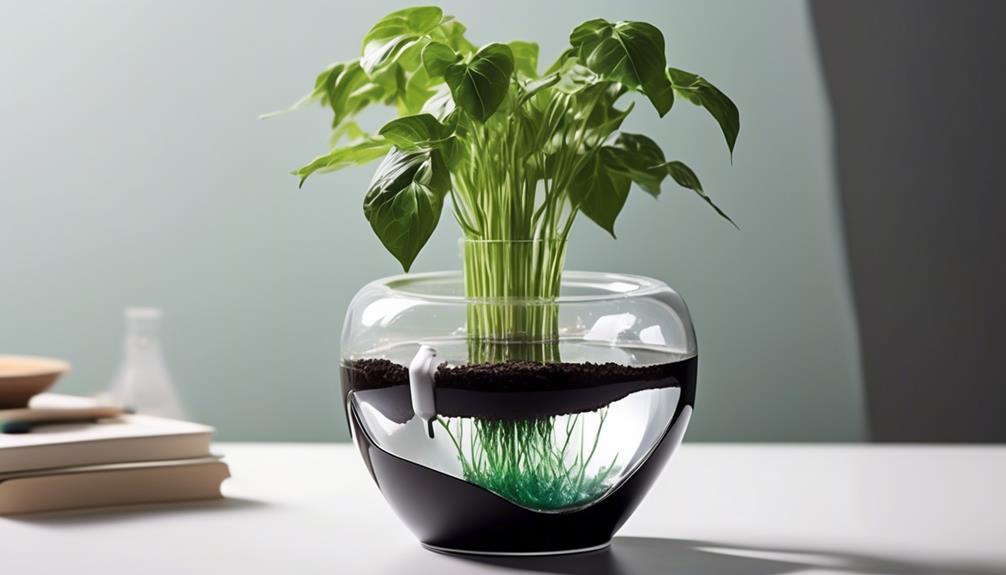
Utilizing a capillary action mechanism, the self-watering pots function by providing a consistent supply of moisture to the plant's roots through a reservoir system. This mechanism involves the following key processes:
- Capillary action: The potting mix or soil in the growing container wicks water from the reservoir through a series of small channels, ensuring a steady uptake of moisture by the plant roots.
- Osmosis: Water moves from an area of high concentration (the reservoir) to an area of low concentration (the soil), ensuring that the plant's roots have access to water as needed.
- Root interaction: The plant's roots grow and spread through the potting mix, coming into direct contact with the moist soil, allowing for efficient water uptake and plant hydration.
The self-watering pots' watering mechanism, which operates on the principles of capillary action, osmosis, and root interaction, ensures a consistent and reliable supply of water to the plant's roots, promoting healthy growth and reducing the risk of overwatering or underwatering.
Advantages of Self-Watering Pots
With self-watering pots, plants receive a consistent supply of moisture essential for their growth and health, leading to several advantages in plant care.
One of the primary benefits is watering efficiency. Self-watering pots reduce water wastage through evaporation and drainage, as the water is directly absorbed by the plant's roots as needed. This efficient watering system also minimizes the risk of overwatering, a common issue in traditional pots, which can lead to root rot and other plant health problems.
Additionally, the consistent moisture levels provided by self-watering pots promote healthier root development and overall plant health. By maintaining optimal moisture levels, these pots create a stable environment for plants, reducing stress and promoting steady growth. This also enhances the plants' resilience to environmental fluctuations, making them more adaptable and robust.
The self-regulating nature of these pots also benefits busy individuals or frequent travelers, as it reduces the frequency of watering required and helps to sustain healthy plants even during periods of absence.
Different Self-Watering Pot Designs
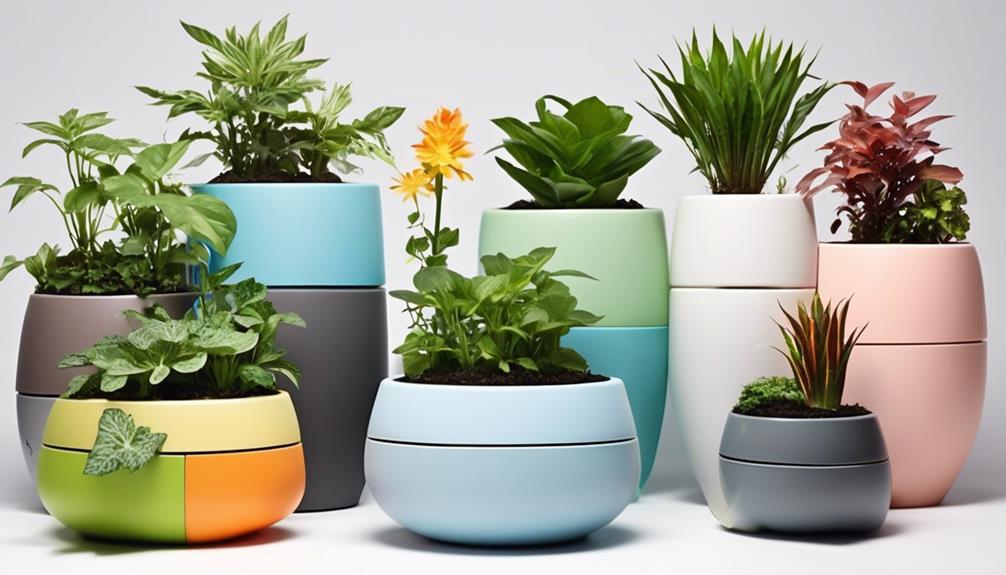
Let's explore the various designs of self-watering plant pots, including reservoir-based watering and wick-based hydration.
Reservoir-based watering systems typically involve a separate compartment for water below the soil, allowing the plant's roots to draw moisture as needed.
On the other hand, wick-based hydration utilizes a wick to transport water from a reservoir to the soil, ensuring a consistent and controlled supply of moisture for the plant.
Reservoir-Based Watering
In self-watering plant pots, various reservoir-based designs provide an efficient means of supplying water to the plants. These designs utilize capillary action and gravity to deliver water to the plant's roots, ensuring consistent moisture levels for optimal growth.
The reservoir-based watering systems offer several advantages, including:
- Sustained Hydration: The reservoir continuously provides water to the plant, ensuring it remains hydrated even during periods of low humidity or high temperatures.
- Reduced Frequency of Watering: With a larger water reservoir, the frequency of refilling the pot is significantly reduced, making it ideal for busy individuals or frequent travelers.
- Prevention of Overwatering: The design prevents waterlogging by allowing the plant to draw water as needed, minimizing the risk of root rot.
These reservoir-based designs represent an innovative approach to plant hydration techniques, promoting efficient water usage and healthy plant growth.
Wick-Based Hydration
An effective method for providing consistent moisture to plants in self-watering pots is through wick-based hydration, where a wick extends from the water reservoir to the soil, allowing water to be drawn up through capillary action. This technique ensures a steady supply of water to the plant roots, promoting healthy growth and reducing the risk of overwatering or underwatering.
| Wick-Based Hydration | Description | Benefits |
|---|---|---|
| Capillary Action | Water moves from the reservoir to the soil via the wick, sustaining moisture | Consistent hydration for plants |
| Wick Material | Porous material like cotton, nylon, or felt absorb and transport water | Efficient water distribution to plant roots |
| Suitable Plants | Ideal for moisture-loving plants such as ferns, peace lilies, and spider plants | Promotes optimal growth in specific plant species |
Wick-based irrigation is a reliable and efficient plant hydration technique, particularly suitable for maintaining moisture levels in self-watering pots.
Suitable Plants for Self-Watering Pots
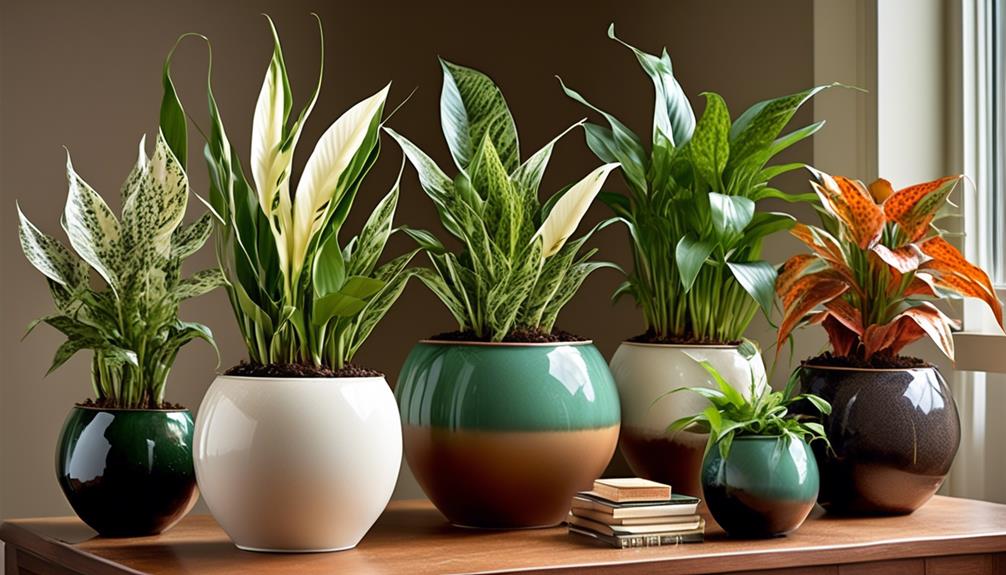
Selecting the appropriate plant species for self-watering pots is crucial for ensuring optimal growth and health. When choosing plants for self-watering pots, it's important to consider their water requirements, growth habits, and root systems.
Some suitable plants for self-watering pots include:
- Succulents: Plants such as aloe vera, jade plants, and echeverias are excellent choices for self-watering pots as they have low water requirements and are adapted to storing water in their leaves and stems.
- Herbs: Culinary herbs like basil, thyme, and parsley thrive in self-watering pots, benefiting from consistent moisture levels that these pots provide.
- Tropical Plants: Species like peace lilies, spider plants, and pothos are well-suited for self-watering pots due to their preference for consistently moist soil and their ability to thrive in humid environments.
These plants are well-suited for self-watering pots due to their ability to adapt to the consistent moisture levels that these pots provide. When selecting plants for self-watering pots, ensure they're compatible with the wick-based hydration or reservoir system of the pot, and consider their specific watering needs to promote healthy growth.
Self-Watering Pot Size Considerations
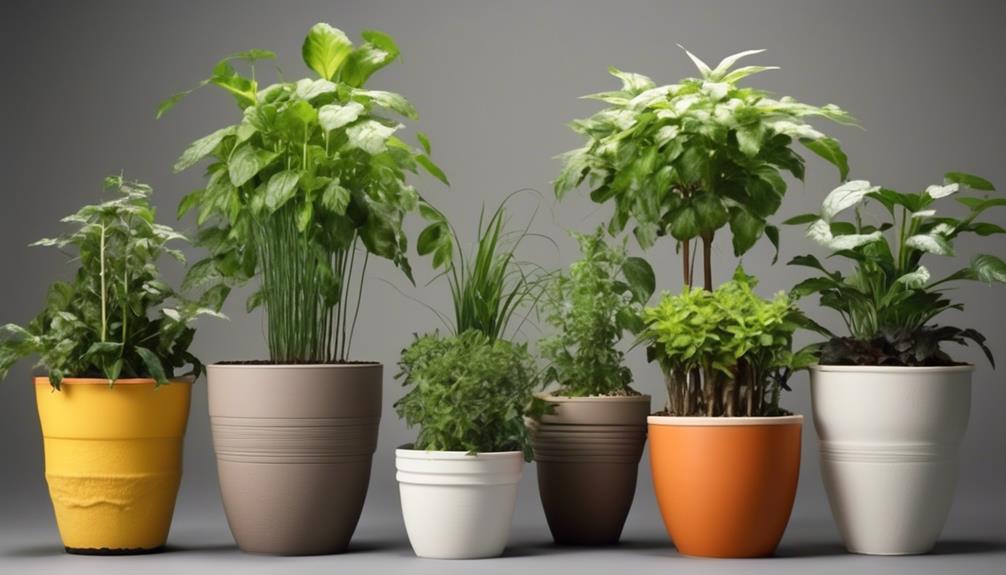
When considering the size of self-watering pots, it's important to match the pot size with the specific needs of the plant.
Different plants have varying water requirements, and selecting the appropriate pot size can ensure that the plant receives the right amount of water.
Understanding the water needs of the plant is crucial in determining the optimal self-watering pot size for healthy growth.
Pot Size Importance
We must consider the importance of pot size when selecting self-watering pots for our plants, as it directly impacts their growth and overall health. The pot size influences the plant's root development, moisture retention, and nutrient availability.
- Root Development: The size of the pot determines the space available for the roots to grow and expand, directly impacting the plant's overall health and stability.
- Moisture Retention: Larger pots have higher water-holding capacity, providing a more stable and consistent moisture environment for the plant's roots.
- Nutrient Availability: The pot size affects the amount of nutrients available to the plant, as larger pots can accommodate a greater volume of soil, leading to improved nutrient uptake and overall plant health.
Selecting the appropriate pot size is crucial for optimizing plant growth and ensuring efficient self-watering capabilities.
Plant Watering Needs
Considering the watering needs of plants in relation to self-watering pot size is essential for ensuring proper hydration and growth.
Plant hydration is dependent on the capacity of the pot to provide water and the plant's ability to uptake it.
When selecting a self-watering pot, it's crucial to match the pot size with the plant's watering requirements.
Larger pots with self-watering systems are suitable for plants with high water demands, as they can store more water and sustain the plant for longer periods.
Conversely, smaller pots are more suitable for plants with lower water requirements.
Understanding the specific watering techniques of different plants is vital for determining the appropriate self-watering pot size.
Watering Frequency With Self-Watering Pots
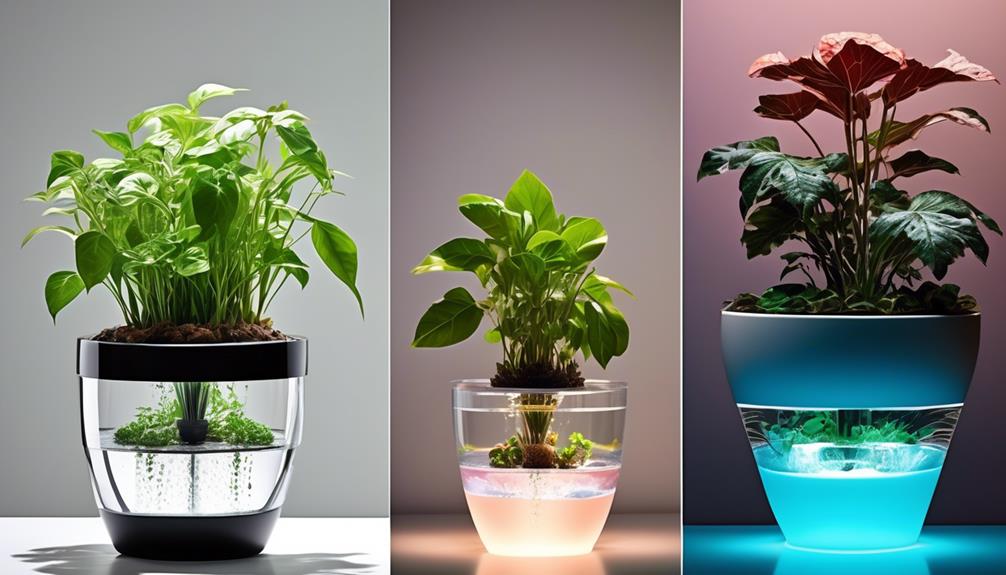
In determining the watering frequency for plants in self-watering pots, it's essential to consider the specific water requirements of each plant species and the environmental conditions in which the pots are situated. Different plants have varied needs, and factors such as humidity, temperature, and light levels can influence their water intake.
When using self-watering pots, the following points should be considered:
- Plant Species: Each plant species has its own unique water requirements. Some plants prefer consistently moist soil, while others may need periods of drying out between watering to prevent root rot.
- Environmental Conditions: The surrounding environment plays a significant role in the watering frequency. Higher temperatures and lower humidity levels can lead to increased water evaporation, requiring more frequent refilling of the self-watering pots.
- Monitoring Moisture Levels: Regularly check the moisture levels in the soil to ensure that the plants are receiving adequate water without becoming waterlogged, which can lead to root suffocation and other detrimental effects on plant health.
Understanding Self-Watering Pot Reservoirs
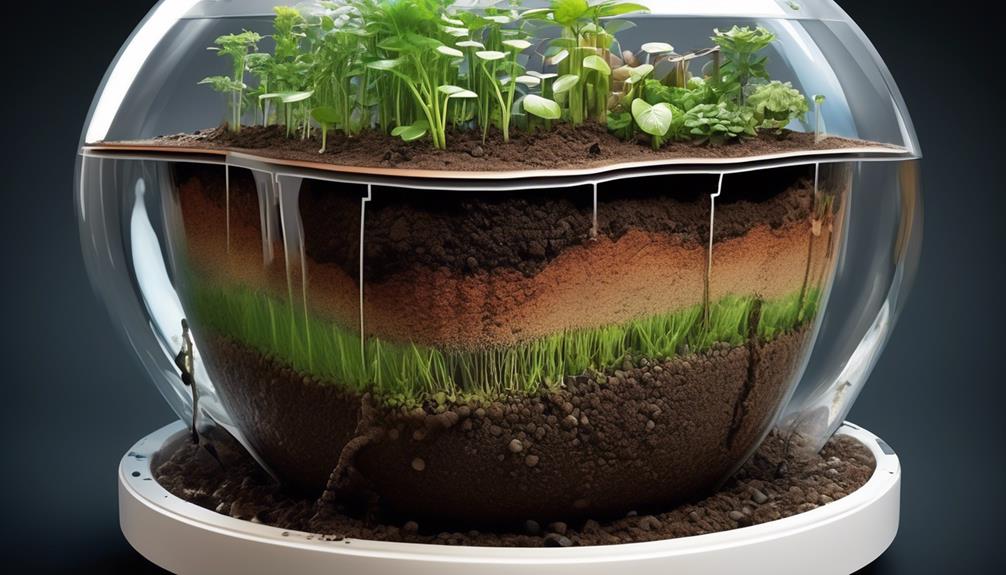
Understanding the functionality of self-watering pot reservoirs is integral to comprehending their role in maintaining plant hydration. Self-watering pot reservoirs are designed to provide a consistent and efficient supply of water to plants. These reservoirs come in various shapes and sizes, but their basic principle remains the same – to ensure that plants have access to water as and when needed. Below is a comparison between self-watering pot reservoirs and traditional watering systems:
| Self-Watering Pot Reservoirs | Traditional Watering Systems |
|---|---|
| Automatically provide water to plants as needed | Require manual watering on a regular basis |
| Prevent overwatering and underwatering | May lead to inconsistent watering, causing stress to plants |
| Allow for longer periods between watering | Require frequent monitoring and adjustment |
| Ideal for busy individuals or frequent travelers | Depend on consistent attention from caretakers |
| Promote healthier root development | May lead to root rot if overwatered |
Self-watering pot benefits include improved water efficiency, reduced maintenance, and healthier plant growth. By understanding the advantages of self-watering pot reservoirs and comparing them to traditional watering systems, plant enthusiasts can make informed decisions about the most suitable watering method for their green companions.
Choosing the Right Soil for Self-Watering Pots
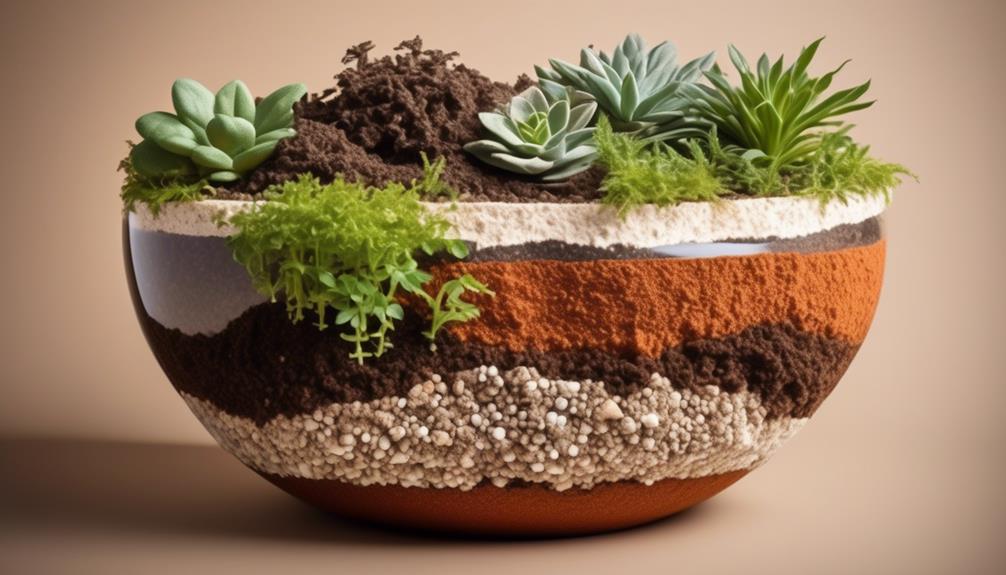
Choosing the right soil for self-watering pots is crucial for creating an optimal growing environment for plants. The soil in self-watering pots should have specific characteristics to ensure proper water distribution and aeration.
- Water Retention: The chosen soil should have good water retention properties to ensure that the reservoir maintains an adequate water supply for the plants. Look for a potting mix that contains materials such as coco coir or peat moss, which can hold onto moisture and release it gradually to the plant roots.
- Aeration and Drainage: It's essential to select a soil mix that provides good aeration and drainage to prevent waterlogging. Incorporating perlite, vermiculite, or coarse sand into the soil can help improve its structure, allowing oxygen to reach the roots while excess water is efficiently drained.
- Nutrient Content: Opt for a soil mix that's rich in nutrients to support plant growth. Consider using a potting mix that contains organic matter like compost or well-rotted manure to provide essential nutrients for the plants.
When choosing soil for self-watering pots, it's important to consider the watering schedule and the specific needs of the plants to create an ideal growing medium that promotes healthy root development and overall plant growth.
Maintenance Tips for Self-Watering Pots
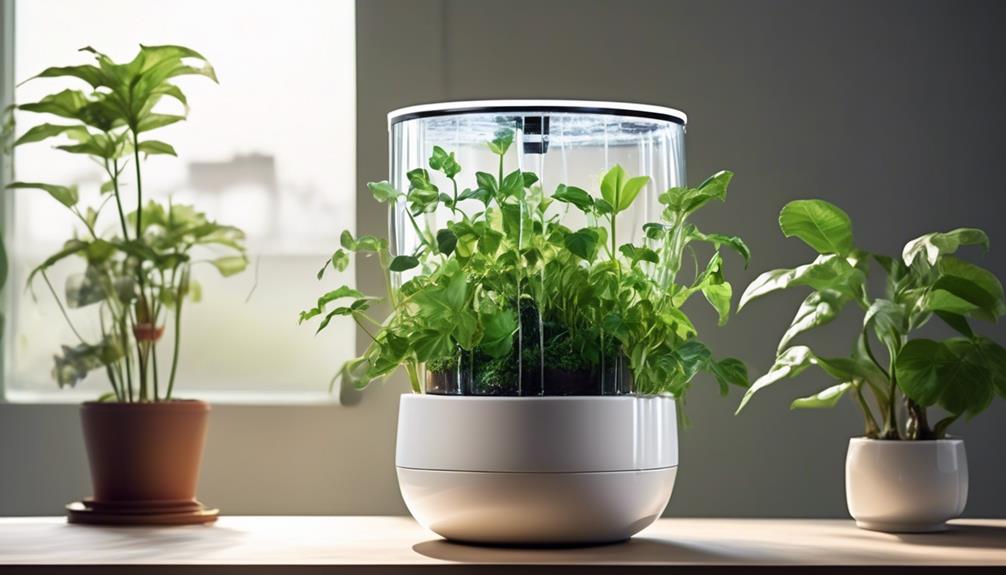
As plant enthusiasts, we understand the importance of maintaining the optimal conditions for our green friends.
When it comes to self-watering pots, choosing the right potting soil is crucial for providing the necessary nutrients and moisture retention.
Additionally, monitoring water levels is essential to prevent overwatering or underwatering, ensuring the best environment for plant growth.
Potting Soil Selection
In selecting potting soil for self-watering pots, it's crucial to prioritize moisture-retaining and well-draining properties to support optimal plant health and growth. The right potting soil can significantly impact the success of self-watering pots.
When choosing potting soil, consider the following:
- Soil moisture: Look for a potting mix that contains ingredients such as peat moss, coconut coir, or vermiculite, as these help retain moisture, ensuring a steady water supply for the plant.
- Drainage considerations: Opt for a mix with perlite or sand to facilitate proper drainage, preventing waterlogging and root rot.
- Nutrient content: Select a potting soil with added organic matter or slow-release fertilizers to provide essential nutrients for the plants' sustained growth.
The selection of potting soil plays a vital role in maintaining the balance of moisture and nutrients within self-watering pots, ultimately supporting healthy plant development.
Monitoring Water Levels
To ensure optimal plant hydration, it's essential to regularly monitor the water levels in self-watering pots. This practice is critical for sustaining the health and growth of the plants.
Monitoring technology, such as water level sensors and automatic watering systems, plays a crucial role in maintaining the appropriate moisture levels in the potting soil. These systems enable precise soil moisture monitoring, allowing for smart irrigation solutions that adjust watering based on the specific needs of the plants.
By utilizing such technology, we can ensure that the plants receive the right amount of water at the right time. This promotes healthy root development and overall plant vigor.
Regularly checking and calibrating the monitoring technology in self-watering pots is fundamental for achieving the best results and ensuring the thriving of the plants.
DIY Self-Watering Pot Options

We can create our own self-watering pots using simple materials found at home, such as plastic bottles or containers, to provide a reliable water supply for our plants. DIY self-watering systems offer several benefits, including consistent moisture levels, reduced risk of overwatering, and increased plant health.
To construct a DIY self-watering pot, we can follow these simple steps:
- Choose a suitable container: Select a plastic bottle or a deep, narrow container that can fit inside the plant pot.
- Create a wick: Cut a strip of fabric or use a shoelace to create a wick that will draw water from the reservoir to the soil.
- Assemble the self-watering system: Place the container with the wick in the center of the plant pot, fill it with water, and cover it with a layer of soil. This will allow the wick to draw water up to the plant's roots as needed.
These DIY self-watering pot options are cost-effective and efficient, providing an excellent way to maintain optimal moisture levels for our plants.
Using Fertilizer With Self-Watering Pots
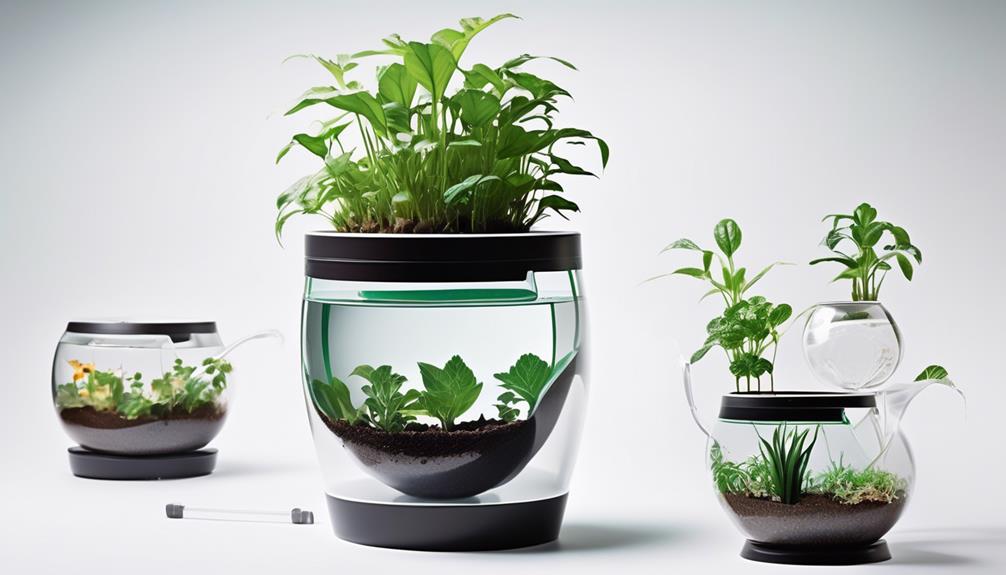
Using the appropriate fertilizer in conjunction with self-watering pots ensures optimal nutrient levels for plant growth and development. Fertilizer application in self-watering pots requires a balanced approach to nutrient management. When choosing a fertilizer for self-watering pots, it's essential to opt for a well-balanced, water-soluble fertilizer specifically formulated for container plants. These fertilizers are designed to release nutrients gradually, aligning with the consistent moisture levels in self-watering pots.
When applying fertilizer, it's crucial to follow the manufacturer's instructions to prevent over-fertilization, which can lead to salt accumulation in the potting mix. This accumulation can disrupt the osmotic balance of the self-watering system and harm the plants. Monitoring the plant's growth and appearance can help in adjusting the fertilizer application to meet the plant's specific needs.
Additionally, periodic flushing of the potting mix with water can help prevent salt buildup. This involves thoroughly watering the pot until water runs out of the drainage holes, carrying excess salts away from the root zone. Proper fertilizer application in self-watering pots is integral to maintaining a healthy and thriving container garden.
Conclusion and Final Thoughts
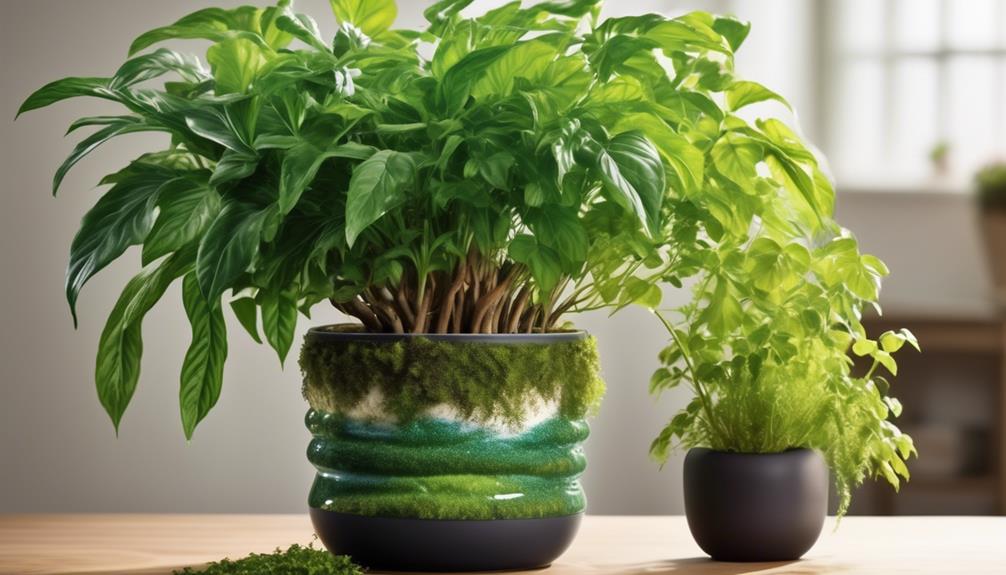
Balancing nutrient management in self-watering pots is critical for maintaining optimal plant growth and preventing salt accumulation, which can disrupt the osmotic balance of the system and harm the plants.
In conclusion, self-watering pots offer several benefits, including efficient water usage, reduced risk of overwatering, and improved plant health.
Some final thoughts on the benefits of self-watering pots include:
- Efficient Water Usage: Self-watering pots provide a reservoir for water, allowing plants to draw moisture as needed. This efficient water usage can result in healthier root systems and reduced water wastage.
- Reduced Risk of Overwatering: The self-regulating nature of these pots prevents overwatering, a common issue that can lead to root rot and other plant diseases. This feature is particularly beneficial for individuals who may not have the time to consistently monitor and water their plants.
- Improved Plant Health: By maintaining consistent moisture levels and minimizing the risk of water stress, self-watering pots promote overall plant health, leading to lusher foliage and more robust growth.
Frequently Asked Questions
Can Self-Watering Pots Be Used for Outdoor Plants?
Yes, self-watering pots can be used for outdoor plants. They provide a consistent water supply, ideal for outdoor plant care, reducing watering frequency. The design ensures water is evenly distributed, promoting healthy root growth.
The pots are durable, suitable for outdoor conditions. This system is particularly beneficial during hot weather or when plants require consistent moisture. It's a practical solution for maintaining optimal moisture levels for outdoor plants.
Do Self-Watering Pots Require Electricity or a Water Source to Function?
Self watering pots function without requiring electricity or a water source. They use a water reservoir and a wicking system to deliver water to the plant's roots as needed. This sustainable solution benefits plants by providing consistent moisture levels and reduces the frequency of watering.
In terms of maintenance, self watering pots are cost-effective as they minimize water wastage and ensure efficient use of resources, making them an excellent choice for plant care.
Can Self-Watering Pots Be Used for Plants That Require a Lot of Water?
Self-watering pots are an excellent option for plants that require a lot of water. They can help maintain the appropriate watering frequency, promoting optimal plant health.
Are Self-Watering Pots Suitable for Beginners or Those With a Busy Lifestyle?
Self-watering pots are suitable for beginners or those with a busy lifestyle. They help regulate watering frequency, promoting healthy plant growth. Sustainability and water conservation are also benefits, as these pots reduce water waste.
The self-watering mechanism ensures that plants receive the right amount of water, making it easier to maintain them. This is particularly beneficial for individuals who may not have the time to monitor and water their plants regularly.
Can Self-Watering Pots Be Used for Plants That Are Sensitive to Overwatering?
Self-watering pots can be used for plants that are sensitive to overwatering. By regulating the moisture levels, these pots prevent overwatering and promote plant health.
The self-watering system ensures a consistent watering frequency, which is crucial for sensitive plants. This feature aids in maintaining optimal plant care, especially for species that are prone to root rot or other issues related to excess moisture.
Are Self Watering Plant Pots and Self Watering Pots the Same Thing?
Yes, self watering plant pots and self watering pots are the same thing. The self watering pot explanation is simple: these pots have a built-in irrigation system that allows plants to draw water from a reservoir as needed, making it easier to maintain healthy plants.
Conclusion
In conclusion, self-watering pots offer a convenient and efficient way to keep plants hydrated without the need for constant monitoring and watering.
With their innovative design and reservoir system, these pots provide a consistent water supply to plants, promoting healthy growth and reducing the risk of overwatering.
Whether you're a beginner or experienced gardener, self-watering pots are a game-changer for maintaining lush and thriving greenery in your home or garden.

